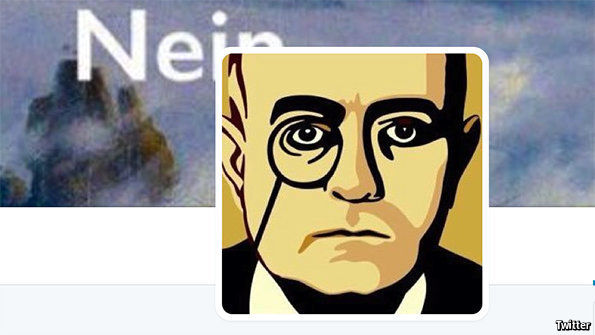
DIGITAL media are often (fairly) derided for playing to short attention spans. But brevity need not be synonymous with simplicity. New technologies also offer a canvas for creativity—even if the palette is confined to 140 characters. Many an artist or author is adept at using online channels to promote their work, and projects like the Los Angeles Review of Books have embraced an internet-first ethos. But there are also writers producing work with a distinctively online mindset. Though the medium is not quite the message, the limitations imposed by Twitter make for particularly fertile ground, giving rise to what has been called “Twitterature”.
Among the more prominent—and professional—Twitterary practitioners is Eric Jarosinski, a former professor of German literature and philosophy at the University of Pennsylvania. He is the writer behind Nein. Quarterly, a Twitter account complete with an avatar that is a cartoonish mock up of Theodor Adorno, a critical theorist, wearing a monocle. Nein. has 134,000 followers. In 2014, Mr Jarosinski jettisoned a book on the concept of transparency in politics and architecture, and the tenured job that would have come with it, to take to Twitter full time, composing primarily on his smartphone.
Many of his tweets read like 19th century philosophical aphorisms. This short, but substantive, form is long established, but Mr Jarosinski produces them with a knowing 21st century slant, a snarky, dour yet humorous tone for a millennial zeitgeist. He plays on current events, romantic German metaphysics and sarcasm. A typical recent passage: “Don’t worry, world. Trump won’t be elected president of the United States. He’ll be elected post-democratic corporate dictator. Of us all.” “Most of what I do will cross the line pretty easily between and aphorism and joke. That is intentional,”Mr Jarosinski says. “It comes without the same kind of truth claim.”
Behind the seemingly irreverent Tweets lies complex thinking about how to address the audience. In such limited space, pacing, punctuation and voice have added relevance. Whereas poets may debate where to place a line break or a novelist questions how best to organise stories into chapters, a writer on Twitter thinks carefully about where to place a comma, or whether a semi-colon might work better.
Another Twitterature adherent, Jean-Yves Frechette, a Quebec-based poet and performance artist, notes that Mr Jarosinski tries “bring something slow to Twitter which is otherwise moving fast”. Tweets are generally encountered as a reader scrolls through a stream of disparate messages that can include breaking news, trolling, the latest humorous meme and a message from a friend about where to meet up later that night. For true Twitterature, tempo and tone must match to make Tweets stand out—and up—on their own.
In another of his recent tweets, this one a rather dystopian bedtime message, Mr Jarosinski writes: “In case of emergency: please be advised that your philosophy can be used as a hammer. To break the dreams behind the glass. #gutenacht”. Approaches vary, but Mr Jarosinski’s style generally addresses its audience directly (“Should you need me…,” for example or, “BELGRADE, get your floating signifiers and šljivovica ready…”), not unlike the way Dostoyevsky used to target his “dear reader”. “I see what I am doing as an interruption of what somebody is thinking about, because the only context people have on Twitter is Twitter,” Mr Jarosinski says.
Among Francophones, Mr Frechette (who deploys a variety of online personas including the shadowy Pierre-Paul Pleau) and a group of poets have taken to Twitter to revive haiku and other ultra-brief poetry. In one recent contribution the mythical Mr Pleau writes: “On s’épuise si vite à croire au bonheur. Mieux vaudrait rester neutre. C’est-à-dire broyé. Ou finement moulu. Concassé. Pulvérisé. Annihilé"—"One gets quickly tired of believing in happiness. It would be better to stay neutral. That is, crushed. Or finely ground. Smashed. Pulverised. Annihilated.'
Mr Frechette and others eventually created the Institute de twittérature comparée (the Institute of Comparative Twitterature), a sort of collective of “artists digging into technology to see what kind of transgressions we can make,” Mr Frechette says. “There is something very interesting to take these ancient tools that belong to human intelligence—language—and to say that the complexity of human mind can also express itself with these new technological devices,” Mr Frechette says. “In between Lady Gaga and the BBC, there is this little bouquet of poetry.”
The aesthetic pleasures of these literary nuggets are bringing recognition in what Nietzsche, one Mr Jarosinski’s longtime subjects of study, called the real world. Mr Frechette and his circle stage exhibitions in brick and mortar galleries. Mr Jarosinski has a newspaper column in Die Zeit, a German weekly, has published a book of his aphorisms, and now spends much of his time on the road playing to live audiences. (He spoke to your correspondent as he was slated to speak at Re:publica, a Berlin tech conference).
“I am sort of a link between more established forms and newer technology, and there might be enough intellectual cachet to what I am doing to make it okay,” Mr Jarosinski says. “The pressure publishing is under has made it more open to an experiment like me. Plus, old media still pays.”